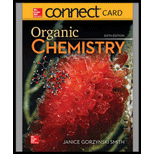
(a)
Interpretation: The product of the given reaction is to be drawn including stereochemistry if appropriate.
Concept introduction: Alkyl tosylates undergo elimination reaction when they are allowed to react with strong nucleophilic base. The mechanism of the elimination reaction is
(b)
Interpretation: The product of the given reaction is to be drawn including stereochemistry if appropriate.
Concept introduction: The reaction of alcohols with halogen acids
(c)
Interpretation: The product of the given reaction is to be drawn including stereochemistry if appropriate.
Concept introduction: Thiols react with
(d)
Interpretation: The product of the given reaction is to be drawn including stereochemistry if appropriate.
Concept introduction: The
(e)
Interpretation: The product of the given reaction is to be drawn including stereochemistry if appropriate.
Concept introduction: Alkyl bromides are obtained by the reaction of
(f)
Interpretation: The product of the given reaction is to be drawn including stereochemistry if appropriate.
Concept introduction: Alcohols are converted into alkyl tosylates by treatment with
(g)
Interpretation: The product of the given reaction is to be drawn including stereochemistry if appropriate.
Concept introduction: The opening of an
(h)
Interpretation: The product of the given reaction is to be drawn including stereochemistry if appropriate.
Concept introduction: The opening of an epoxide/ethylene oxide ring is regioselective either it takes place with a strong nucleophile
(i)
Interpretation: The product of the given reaction is to be drawn including stereochemistry if appropriate.
Concept introduction: Ethers are the most common organic products of nucleophilic substitution reaction. They are prepared from alkyl halides and strong nucleophiles. The reaction proceeds through
(j)
Interpretation: The product of the given reaction is to be drawn including stereochemistry if appropriate.
Concept introduction: Ethers react with strong acids, (only
In this reaction, both
(k)
Interpretation: The product of the given reaction is to be drawn including stereochemistry if appropriate.
Concept introduction: Sulfides are prepared from thiols by the successive treatment of sodium hydride (a good base), and an alkyl halide. The mechanism of the reaction is
(l)
Interpretation: The product of the given reaction is to be drawn including stereochemistry if appropriate.
Concept introduction: Sulfide involves a nucleophilic sulfur atom. It reacts rapidly with unhindered alkyl halide to form corresponding sulfonium ion. The mechanism of the reaction is
Want to see the full answer?
Check out a sample textbook solution
Chapter 9 Solutions
ORGANIC CHEMISTRY-ACCESS
- 7) Please use MO diagrams in your explanations. (10) a) If you remove one electron from O₂, b) does this weaken or strengthen the bond? What charge would N, need to have in order for its Bond Order to be 2.5?arrow_forwardpls helparrow_forwardDon't used hand raiting and don't used Ai solution and correct answerarrow_forward
- Don't used hand raiting and don't used Ai solution and correct answerarrow_forwardPredict the product formed when the compound shown below undergoes a reaction with MCPBA in CH2Cl2. MCPBA is meta-chloroperoxybenzoic acid.arrow_forwardk https://app.aktiv.com STARTING AMOUNT 6 58°F Clear + F1 X Dimensional Analysis - Aktiv Chemistry Your Aktiv Learning trial expires on 02/25/25 at 02:14 PM Question 19 of 22 Polyethylene terephthalate (PET) is used in plastic water bottles. A water bottle has a mass of 14.0 grams. Given a density of 1.38 g/cm³, what is the volume of the plastic used to make the water bottle in cm³ ? ADD FACTOR ANSWER RESET ว 100 14.0 0.01 10.1 1000 0.099 1.38 0.001 Q Search F5 -O+ F6 F7 + F3 F2 W E S4 ST #3 F4 % 5 Y R S & 7 cm³ g/cm³ g ם F8 * 00 8 F9 P ل DOD S F10 F11 F12 Insert D F G H J K + 11arrow_forward
- A doctor gives a patient 10 Ci of beta radiation. How many betaparticles would the patient receive in 1 minute? (1 Ci = 3.7 x 1010d/s)arrow_forwardPart C IN H N. Br₂ (2 equiv.) AlBr3 Draw the molecule on the canvas by choosing buttons from the Tools (for bonds and + e (×) H± 12D T EXP. L CONT. דarrow_forward9. OA. Rank the expected boiling points of the compounds shown below from highest to lowest. Place your answer appropriately in the box. Only the answer in the box will be graded. (3) points) OH OH بر بد بدید 2 3arrow_forward
 ChemistryChemistryISBN:9781305957404Author:Steven S. Zumdahl, Susan A. Zumdahl, Donald J. DeCostePublisher:Cengage Learning
ChemistryChemistryISBN:9781305957404Author:Steven S. Zumdahl, Susan A. Zumdahl, Donald J. DeCostePublisher:Cengage Learning ChemistryChemistryISBN:9781259911156Author:Raymond Chang Dr., Jason Overby ProfessorPublisher:McGraw-Hill Education
ChemistryChemistryISBN:9781259911156Author:Raymond Chang Dr., Jason Overby ProfessorPublisher:McGraw-Hill Education Principles of Instrumental AnalysisChemistryISBN:9781305577213Author:Douglas A. Skoog, F. James Holler, Stanley R. CrouchPublisher:Cengage Learning
Principles of Instrumental AnalysisChemistryISBN:9781305577213Author:Douglas A. Skoog, F. James Holler, Stanley R. CrouchPublisher:Cengage Learning Organic ChemistryChemistryISBN:9780078021558Author:Janice Gorzynski Smith Dr.Publisher:McGraw-Hill Education
Organic ChemistryChemistryISBN:9780078021558Author:Janice Gorzynski Smith Dr.Publisher:McGraw-Hill Education Chemistry: Principles and ReactionsChemistryISBN:9781305079373Author:William L. Masterton, Cecile N. HurleyPublisher:Cengage Learning
Chemistry: Principles and ReactionsChemistryISBN:9781305079373Author:William L. Masterton, Cecile N. HurleyPublisher:Cengage Learning Elementary Principles of Chemical Processes, Bind...ChemistryISBN:9781118431221Author:Richard M. Felder, Ronald W. Rousseau, Lisa G. BullardPublisher:WILEY
Elementary Principles of Chemical Processes, Bind...ChemistryISBN:9781118431221Author:Richard M. Felder, Ronald W. Rousseau, Lisa G. BullardPublisher:WILEY





